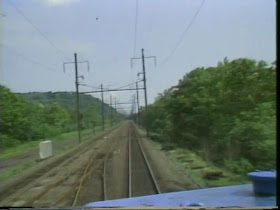We begin with the MP 43 ABS signal location. Mileposts are prefixed from L which start at PARK interlocking on the Main Line. The westbound signal is a two head PRR PL mast while the eastbound signal is mounted on a catenary pole. Both signals are equipped with US&S PL equipment.
Automatic L433 is the distant signal to SHOCKS interlocking and is therefore capable of displaying Approach Medium using the | lower had. Default indication is Approach. Note the 100hz signal power supply on the cat pole.
Backlit view in the eastbound direction showing the two 138kv 25hz power circuits feeding both the east and west banks of the Susquehanna River between here and Harrisburg.
ABS signal L434 is a single head PRR Pl signal with a default indication of Clear.
Back before the 1980's railroad signals were required to be mounted to the right hand side of the track they governed and exceptions required an FRA waiver. A good reason for the PRR to avoid 261 operation on its 2-track lines would be to save money building and maintaining signal bridges like this one used for reverse direction movements on track #2. There are only two block sections on track #2 between SHOCKS and LAKE wherein the "correct" direction has 3.
ABS signal L424 is equipped with a lower head for Approach Medium indications as the 99 switch at LAKE allowed for medium speed moves into the center siding track. This signal is displaying Stop and Proceed as traffic is set in the opposite direction.
ABS signal L415 for westbound trains on track #2 is a mast signal similar to L433 just without the lower head. It's default indication is Clear.
The L416 signal on track #1 for eastbound trains is a bit more interesting. As a distant to CP-LAKE it was equipped with a lower head containing both | and / positions for Approach Medium and Approach Slow. The Approach Medium was for the #97 crossover at CP-LAKE, which was removed around 1985. The Approach Slow was for the #10 crossover into the center siding (which was afforded a Medium speed route off track #2). The | position was eventually removed, but at some point in the early 1990's the connection from the Lake siding to #1 track was removed and the L416 automatic was never updated.
In this screen capture from a 1986 cab ride video we can see both of the original positions.
LAKE interlocking, later known as CP-LAKE is the final stop on today's tour. Due to spotty coverage in the 2004 survey I will need to rely on a combination of cab video caps and other online sources. We begin with a shot of the two eastbound catenary gantry mounted high signals with 100L governing track 2 and 96L track 1. Best possible indication on the 100L was Approach Medium as the 261 operation ended at COLA interlocking. The lower / could be used to display Medium Approach for routes onto the center siding or Approach Slow for a diverging move onto the Columbia Branch at COLA. The 96L still retains its lower | for the removed medium speed 97 crossover.
Here is the original Y setup for access to the center siding. The track 2 access uses the single turnout medium speed 99 switch. The track 1 access uses a slow speed crossover with each end controlled by the 95 lever. In 1986 LAKE was a pneumatic plant, but when the 95 crossover was removed sometime in the 1995's the sole remaining 99 switch was converted to an M23 electric.
Here is an overhead view of the current configuration of CP-LAKE with a single electric switch from 2 track onto the siding. The old school relay house is located on the east side of the tracks.
Here are the current eastbound signals at CP-LAKE. The interlocking is now in service on track #2 only, with the signal on track #1 being converted into the MP 40 automatic.
Here is the present day CP-LAKE looking eastbound with the MP40 milemarker, the single switch and a crude oil train parked on the siding.
For westbound trains CP-LAKE features the 100R high signal on track 2, the 96R dwarf wrong direction movements on track #1 and the 98R dwarf for trains coming off the center siding. The 100R features a Stop and Proceed marker for a lower head with the 98R retaining the ability to display Slow Clear and Slow Approach for westbound movements onto track 1. The 96R is the typical Stop-Restricting type for wrong direction movements.
Wider view of CP-LAKE looking westbound.

In our final photo we see the present day westbound color light signals at CP-LAKE. In the distance is the track 1 automatic. The brackets for the old 96L and 100L signals are still in place on the catenary gantry.
Well that is it for the section between SHOCKS and COLA. Next week we will tackle the extensive interlocking plant that makes up COLA interlocking proper as well as the tower that stands there.
















The crossover at Lake was removed in 1983. The connection from Track 1 to Lake siding was removed in 1997.
ReplyDelete